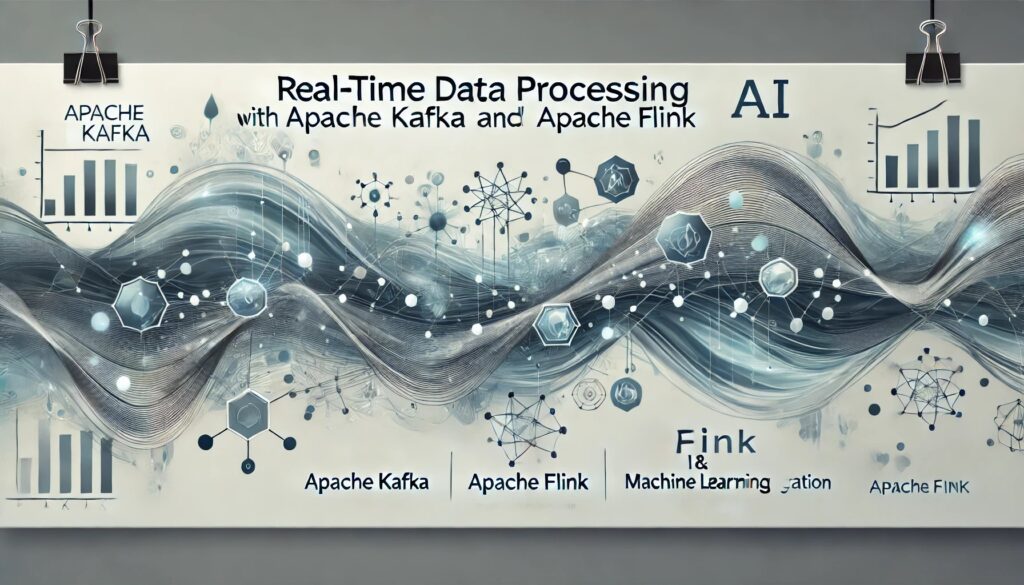As we have explored in the previous parts of this series, high-quality and real-time data are essential for AI and ML applications. Now, let’s take a deeper look into how to implement real-time data products effectively using Apache Kafka and Apache Flink. This part focuses on two crucial features of Flink that enable reliable and scalable stream processing: event-time processing and exactly-once semantics.
Event-Time Processing: Handling Late-Arriving Data Accurately
One of the main challenges in real-time data processing is dealing with out-of-order and late-arriving events. Traditional batch systems rely on processing time, meaning they process data based on when it arrives at the system. However, in real-world scenarios—such as financial transactions, IoT sensor readings, or user interactions—data can arrive late due to network delays, processing bottlenecks, or distributed system complexities.
Flink’s event-time processing ensures that events are processed based on their actual occurrence time, not when they are received. This is done using watermarks, which track the progress of event-time and define how much delay can be tolerated before considering data as late.
Key advantages of Flink’s event-time processing:
- Accurate aggregations: Ensures that windows (e.g., 5-minute sales data) correctly include all relevant events, even if they arrive late.
- Consistent AI model inputs: Reduces inaccuracies caused by missing or misaligned data, which is critical for ML-based decision-making.
- Flexible lateness handling: Allows defining how long late events should be accepted before being discarded or sent to a separate stream for further analysis.
For example, in a fraud detection system, financial transactions might arrive with delays due to network issues. Using event-time processing, Flink ensures that the fraud detection model always considers transactions within the correct time window, even if they arrive out of order.
Exactly-Once Semantics: Ensuring Data Accuracy in Streaming Pipelines
Another critical requirement for real-time data products is data consistency. Many systems struggle with duplicate events, which can lead to incorrect aggregations, double-counting, and unreliable AI predictions.
Flink provides exactly-once semantics, which guarantees that each event is processed only once, even in the event of failures or retries. This is achieved through checkpointing and stateful processing, ensuring that:
- If a failure occurs, Flink restores the last known correct state without reprocessing events unnecessarily.
- Transactions to external systems (such as Kafka, databases, or object stores) are committed exactly once, avoiding duplication.
- Stream processing workflows remain reliable, even under high load or unexpected system failures.
For example, in real-time stock trading, processing an order twice could result in significant financial losses. With exactly-once semantics, Flink ensures that trade executions happen precisely once, preventing unintended transactions.
Best Practices for Implementing Real-Time Data Products
Establishing a Clear Event-Time Strategy
To effectively process real-time data, it is essential to define an event-time strategy. This involves using timestamps and watermarks to manage out-of-order data and late arrivals. By ensuring that data is processed based on the time it was generated, businesses can maintain accurate reporting and analysis.
Preventing Data Duplication and Ensuring Consistency
Using Flink’s exactly-once guarantees, organizations can eliminate duplicate records in downstream applications. This is particularly important for financial transactions, inventory management, and AI model training, where duplicate data can cause major inconsistencies.
Optimizing Windowing Strategies
Different use cases require different windowing strategies. Tumbling, sliding, and session windows each serve distinct purposes in stream processing. For example:
- Tumbling windows are ideal for aggregations like hourly sales summaries.
- Sliding windows are useful for rolling analyses, such as monitoring a user’s last five minutes of activity.
- Session windows dynamically adjust to user interactions, making them perfect for behavioral analytics.
Integrating AI/ML Models in Real-Time
To fully leverage AI and ML capabilities, real-time data must be continuously fed into models. Flink enables direct integration with AI frameworks, allowing models to be updated dynamically based on the latest data. This ensures that predictions and insights remain relevant and accurate.
Leveraging Kafka for Scalable Messaging
Apache Kafka plays a crucial role as a durable, distributed message broker. It allows Flink to consume and process data efficiently, ensuring that messages are delivered in the correct order and at scale. By integrating Kafka and Flink, organizations can create robust real-time data pipelines.
Conclusion
Apache Kafka and Apache Flink provide a powerful combination for building scalable, real-time data products. Flink’s event-time processing ensures AI/ML models receive accurate, context-rich data, even when events arrive late. Exactly-once semantics guarantees data consistency, preventing errors and improving reliability.
By applying these technologies effectively, businesses can build AI-driven, real-time decision-making systems that respond to events as they happen, ensuring better operational efficiency, predictive accuracy, and overall performance.
This concludes our three-part series on data products for AI and ML with real-time streaming. With a strong foundation in data quality, real-time processing, and scalable architectures, organizations can unlock the full potential of AI and ML in their data-driven strategies.

